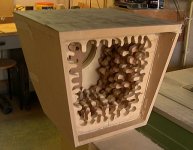Dear All,
I'm looking for disign the "best" cabinet with the very low resonance and send away the standing waves from the inside of the cabinet.
I looking for monitor loudspeakers like Peak Consult InCognito and Rockport Technologies Merak II loudspeaker.
The material that I can to use is only wood (MDF, Plywood...).
What you think can give me the best result, rectangle shape or triangle (asymmetric cabinet).
What about the build cabinet like the picture here? Is really good idea or that is unnecessary and I can get same result with good stuffing?
I open for new and better idea.
Thanks all
I'm looking for disign the "best" cabinet with the very low resonance and send away the standing waves from the inside of the cabinet.
I looking for monitor loudspeakers like Peak Consult InCognito and Rockport Technologies Merak II loudspeaker.
The material that I can to use is only wood (MDF, Plywood...).
What you think can give me the best result, rectangle shape or triangle (asymmetric cabinet).
What about the build cabinet like the picture here? Is really good idea or that is unnecessary and I can get same result with good stuffing?
I open for new and better idea.
Thanks all
Attachments
It seems your design goals are:
1. Prevent the enclosure from producing sound
2. Prevent the rear wave from reflecting and passing through the cone as a delayed source
An enclosure would radiate sound from the vibrations transmitted from the driver and from the variations in the pressure of the internal air volume. The former can be prevented by mechanically isolating the driver from the cabinet (say, a foam gasket for sealing and some sort of rear support for the driver), and the latter can be attenuated with enough stuffing and/or an open back.
Alternatively, you could build an ultra-heavy enclosure, or an constrained-layer-damped enclosure whose walls would convert vibration into harmless amounts of heat.
To prevent the rear wave from escaping through the cone, you can use an open-backed enclosure and stuff it if you don't want dipole operation (the lower the passband, the more stuffing you need), or, as B&W has done, use a driver with a cone whose material is a good insulator of sound (Rohacell in their sub drivers).
You can also build a large and/or deep enclosure and stuff it, with the idea being that the rear wave will have completely dissipated by the time it has propogated to the walls, reflected, and has almost reached the driver. Again, B&W does this with their tapered tube and sphere/inverted horn enclosures.
I'm not quite sure what effect standing waves inside the enclosure would have besides a stronger sound passing through the cone. In any case, in a sealed enclosure, varying the internal dimensions such that none are multiples of each other will distribute the frequencies at which standing waves are prone to occur. Stuffing can then clean up whatever's left.
1. Prevent the enclosure from producing sound
2. Prevent the rear wave from reflecting and passing through the cone as a delayed source
An enclosure would radiate sound from the vibrations transmitted from the driver and from the variations in the pressure of the internal air volume. The former can be prevented by mechanically isolating the driver from the cabinet (say, a foam gasket for sealing and some sort of rear support for the driver), and the latter can be attenuated with enough stuffing and/or an open back.
Alternatively, you could build an ultra-heavy enclosure, or an constrained-layer-damped enclosure whose walls would convert vibration into harmless amounts of heat.
To prevent the rear wave from escaping through the cone, you can use an open-backed enclosure and stuff it if you don't want dipole operation (the lower the passband, the more stuffing you need), or, as B&W has done, use a driver with a cone whose material is a good insulator of sound (Rohacell in their sub drivers).
You can also build a large and/or deep enclosure and stuff it, with the idea being that the rear wave will have completely dissipated by the time it has propogated to the walls, reflected, and has almost reached the driver. Again, B&W does this with their tapered tube and sphere/inverted horn enclosures.
I'm not quite sure what effect standing waves inside the enclosure would have besides a stronger sound passing through the cone. In any case, in a sealed enclosure, varying the internal dimensions such that none are multiples of each other will distribute the frequencies at which standing waves are prone to occur. Stuffing can then clean up whatever's left.
While that enclosure is impressive looking the little wood fingers would only be effective over a limited frequency range and their effect would be totally swamped by a suitable fill, in that particular application they're doing more good as extra mass and bracing on the cabnet walls than any damping/diffraction effect they have.
- Status
- This old topic is closed. If you want to reopen this topic, contact a moderator using the "Report Post" button.
